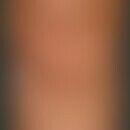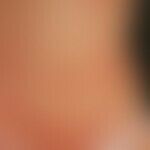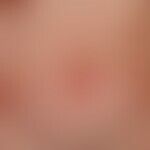Synonym(s)
DefinitionThis section has been translated automatically.
Drug reaction that can only be distinguished from exanthematous lichen planus to a limited extent, in which a temporary connection between the appearance of the exanthema and the drug intake can be proven.
Caution: Between the first intake of the drug and the appearance of the exanthema there are latency periods of 12 months on average. Likewise, weeks and months may elapse between discontinuation of the drug in question and healing of the exanthema. In the last time, lichenoid drug reactions have again received a higher attention since they may not infrequently occur with the administration of biologics or with a "molecular targeted therapy" including a therapy with immune checkpoint inhibitors.
Occurrence/EpidemiologyThis section has been translated automatically.
You might also be interested in
EtiopathogenesisThis section has been translated automatically.
Lichenoid drug reactions are thought to be a T-cell-mediated reaction directed against keratinocyte antigens, cross-reacting with pharmaceuticals. Possibly photoallergic influences play an additional role (localization!).
The preference of quite different groups of drugs is unexplained. The most common drug triggers are (cited from Merk HF et al. 2018):
- ACE inhibitors (captopril, enalapril, ramipril).
- Thiazide diuretics
- Antimalarials
- Penicillamine
- Beta-blockers (acebutal, atenolol, labetalol, levubatanol, metoprolol, nebivolol, oxprenalol, timolol, sotalol)
- HMG-CoA reductase inhibitors (fluvastatin, lovastatin, simvastatin)
- TNF-alpha blockers
- PD-1 and PDL-1 inhibitors
- Other:
It cannot be ruled out that drug reactions may progress to exanthematous lichen planus if the patient is dispositionally reactive.
ManifestationThis section has been translated automatically.
Clientele is slightly older (>60 years) than the average Lichen-planus clientele (50 years). Children are not affected (s. Lp exanthematicus)
ClinicThis section has been translated automatically.
The clinical picture of the lichenoid drug exanthema (LA) is largely similar or morphologically identical to the picture of the lichen planus (LP). However, some clinical differences between the two types of exanthema are noteworthy in terms of differential diagnosis.
The lichenoid drug exanthema is always generalized, but not always LP-typically distributed (e.g. not flexurally emphasized). The exanthema appears more psoriasiform, pityriasis rosea-like or eczematized.
The single florescence may be greater than in the exanthematic LP.
The mucous membranes, especially the oral mucosa, are usually free. In individual cases, however, mucous membrane involvement including sicca syndrome is described.
Photoaggravation is often detectable.
As in LP, the LA can be grouped in the Blaschko lines.
HistologyThis section has been translated automatically.
Typical interface dermatitis with (rather sparse) subepidermal, band-like infiltrate of CD4 and CD8 lymphocytes, eosinophilic leukocytes (evaluated as an important distinguishing feature from LP, as they are absent there) and few plasma cells. Vacuolated degeneration of basal keratinocytes. In contrast to idiopathic lichen planus, parakeratosis can be observed. Furthermore, the deep parts of the dermis may be affected.
Destruction of basal keratinocytes is mainly induced by CD8 cells containing cytotoxic enzymes such as perforin and granzyme B. Focal parakeratosis may be present (always absent in LP!).
General therapyThis section has been translated automatically.
TablesThis section has been translated automatically.
Medication Group |
Active ingredients |
Antimicrobially active substances |
ethambutol, griseofulvin, ketoconazole, streptomycin, tetracyclines, trovafloxacin |
Antihistamines (H2 blockers) |
Ranitidine, Roxatine |
Antihypertensives |
captopril, enalapril, doxazocin, propanolol, methyldopa, prazosin, nifedipine |
Antimalarials |
Chloroquine, hydroxychloroquine, quinidine |
antidepressants/antipsychotics |
amitriptyline, carbamazepine, chlorpromazine, imipramine, lorazepam, phenytoin |
Diuretics |
Hydrochlorothiazide, furosemide, spironolactone |
Antidiabetics |
chloropromamide, glimperide, tolazamide, tolbutamide |
Metals |
Gold salts, arsenic salts, bismuth, mercury, palladium |
NSAID |
acetylsalicylic acid, benoxaprofen, diflunisal, fenclofenac, flurbiprofen, ibuprofen, indometacin, naproxen, sulindac |
Lipid reducers |
Pravastatin, Simvastatin |
Further |
Allopurinol, Amiphenazole, Cinnarizine, Cyanamide, Dapsone, Gemfibrozil, Hydroxyurea, Hepatitis B Vaccine, Imatinib, Immunoglobulins (IVIG), Interferon alpha, L-Thyroxine, Levamisole, lithium, mesalamine, methycran, omeprazole, penicillamine, procainamide, pyrimethamine, pyrithioxine, sildenafil (Viagra), quinine, sotalol, sulfasalazine, trihexyphenide, ursodeoxycholic acid |
LiteratureThis section has been translated automatically.
- Kaur S et al (2003) Subacute lichenoid eruption due to L-thyroxine overdosage. Dermatology 206: 346-347
- Keough GC et al (1998) Pravastatin-induced lichenoid drug eruption. Cutis 61: 98-100
- Merk HF et al (2018) Lichenoid drug exanthema. Dermatologist 69:116-120
- Munoz MA et al (1996) Lichenoid drug eruption following the Blaschko lines. Dermatology 193: 66-67
- Noakes R et al. Lichenoid drug eruption as a result of the recently released sulfonylurea glimepiride. Australas J Dermatol 44: 302-303
- Ruiz Villaverde R et al (2003) Lichen planus-like eruption due to enalapril. J Eur Acad Dermatol Venereol 17: 612-614
- Ruiz Villaverde R et al (2003) Generalized lichen planus-like eruption due to acetylsalicylic acid. J Eur Acad Dermatol Venereol 17: 470-472
- Already MP et al (1994) Lichenoid drug eruption induced by spironolactone. Acta Derm Venereol 74: 476
- Shiohara T, Kano Y (2003) Lichen planus and lichenoid dermatoses. In: Bologna JL et al (ed.) Dermatology. Mosby Publishing House, London New York Toronto, S. 188
- Smith KJ et al (1998) Lichenoid/Interface cutaneous eruptions to IVIg with the primary infusion may be related to the re-regulation of anti-idiotype network. J Cutan Med Surg 3: 96-101
- Teraki Y, Shiohara T (2004) Spontaneous tolerance to terbinafine-induced lichenoid drug eruption. Dermatology 208: 81-82
- Ziemer, M (2014) Late type cutaneous drug reactions. Pathogenesis, Clinic and Histology. Dermatologist 65: 397-408
- Yawalkar N, Pichler WJ (2005) Mechanisms of cutaneous drug-induced reactions. JDDG 2: 1013-1021
Incoming links (8)
Beta-receptor blockers; Drug-induced lichen planus; Exanthema, lichenoides; Granzyme; Interface dermatitis; Lichenoid drug eruptions; Lichen planus exanthematicus; Lichen-ruber-planus-like eruptions;Outgoing links (22)
Ace inhibitors; Antimalarials; Ass intolerance syndrome; Beta-receptor blockers; Biologics in dermatology; Blaschko lines; Diuretics; D-Penicillamine; Granzyme; Hydroxycarbamide; ... Show allDisclaimer
Please ask your physician for a reliable diagnosis. This website is only meant as a reference.










